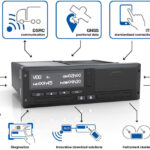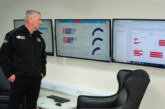The new tachograph EU regulation 165/2014 will mean changes for drivers and fleet operators. Matthias Kliché, Head of Legal Requirements & Homologation Tachographs, Telematics & Services at Continental, and Dirk Gandras, Program Manager, TTS Vehicle Units at Continental, explain the changes.
Over time, the digital tachograph has become more intelligent and from mid-2019, several new
features will be mandatory for all newly registered in-scope vehicles. Road transport and passenger vehicle companies can then expect fewer enforcement checks thanks to the integrated Remote Early Detection Functionality module, which enables the new smart tachograph to be able to communicate with the authorities while the vehicle is in motion. So what exactly does tachograph regulation (EU) 165/2014 cover and how will it change current practices?

The objectives of the new regulation are to improve the security of the digital tachograph against tampering and to increase its efficiency in operational mode. Higher-quality cryptographic mechanisms will be used to enhance security. This will involve a new encryption technology for data transfer from and to driver cards, parallel to the existing technology – so the digital tachograph will ensure that the stored data is available for both the old and the new tachograph generations. Communication between the speed sensor and digital tachographs will be re-encrypted, and the regulation will also control access to a Global Navigation Satellite System (GNSS), so positional data will be automatically recorded at the start and end of the driver’s shift and after every three hours of driving time. The positional data can also be used to support fleet management solutions. The European Commission favours the European
GNSS Galileo, currently under construction, but whether enough satellites will be available by 2019, remains to be seen. Digital tachographs from VDO will certainly be ready for use by the deadline date, since they can also evaluate the data of the American GPS and Russian Glonass systems.
What’s new?
The optional ITS interface (Intelligent Transportation Systems) increases operational efficiency, providing more than 70 items of information from the digital tachograph via a standardised interface. What’s new is that the major part of this information is classified as ‘personal’ and may only be transmitted from the vehicle if the driver has already given approval. This has far-reaching consequences for the suppliers of telematics solutions – because in the future these devices must ensure that data is not communicated externally without the consent of the driver.
f the driver has a tablet PC or a smartphone, they can connect the device to the tachograph via a small Bluetooth add-on module. This makes it possible to have all the relevant data and information on the digital tachograph clearly displayed on the mobile device, facilitating delivery and journey planning.
The tachograph can also be remotely controlled from a tablet or smartphone. The advantage is easier tachograph operation thanks to more extensive graphic capabilities (also possible with today’s digital tachographs). In particular, time-consuming interactions like making manual entries can be configured in advance (offline) and transferred to the tachograph easily and quickly at the start of the shift.
Roadside Checks
The EU regulation requires a standardised Dedicated Short Range Communication (DSRC) interface to make roadside checks more efficient for all those involved. To achieve this, the appropriate authentication is first sent and received, after which a pre-defined, minimum amount of data is transmitted wirelessly from the digital tachograph of the moving vehicle to the devices of the inspection officers. The transmitted data set contains vehicle and calibration data, plus details of security breaches and any malfunctions. No personal data is included. The officers can use this data to immediately stop suspicious vehicles. Companies and drivers who comply with all laws and regulations can expect fewer inspections and unscheduled roadside stops thanks to this change. There is no need to worry about financial penalties, no plans are in place to levy automatic fines based on the transmitted data.
The standardised DSRC interface is also capable of performing other key functions, such as the transmission of data for on- board weighing and toll control verification. In 2021, a Europe-wide legislative change will come into force, stipulating that a measuring device must be integrated in trucks to ensure safe compliance with axle loads and gross vehicle weights. This information will then be transmitted wirelessly via the DSRC interface and used to identify possible breaches of the law, and the Europe-wide standardised toll, already in the planning pipeline can also benefit from this solution.
The new tachograph regulation paves the way for an expandable and multifunctional tachograph solution that reduces outdated techniques, making its use more efficient for drivers and fleet operators. Despite all these future changes, the rules on driving, work and rest periods will remain, but thanks to more transparency, they can be fully exploited more easily within the legal framework, creating a business advantage in the highly competitive road haulage business.
Changes for drivers
Drive-by Checks
- From2019,roadsideinspection officers will be able to wirelessly read out a dataset from the digital tachographs of passing vehicles. The dataset will not contain any personal data about the driver.
- Thisprocessisintendedtoenable suspicious vehicles to be stopped and checked.
- Thechangemeansthatcompanies and drivers who comply with all the legal regulations can expect fewer roadside checks.
- Therearenoplansinplacetolevy automatic fines based on the transmitted data.
New Driver Cards
- Newdrivercardswillbeissuedfor digital tachographs, this is due to a new encryption technique.
- Thenewcardswillbecompatible with older tachographs which are still in use today.
Personal Data
- Thenewregulationenhancesthe protection of drivers’ personal data.
- Mostoftheinformationthatcanbe transmitted via ITS interfaces is classified as ‘personal’. Data may only be transmitted from a vehicle if the driver has consented to this action.









